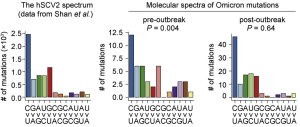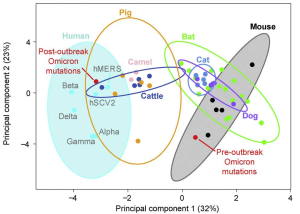A group from University of Chinese Academy of Sciences, Beijing 100049, China has proposed a hypothesis that the progenitor of Omicron evolved in mice.
https://www.ncbi.nlm.nih.gov/pmc/articles/PMC8702434/
Generally speaking, the molecular spectrum of mutations that accumulate in a viral genome reflects a host-specific cellular environment.
The molecular spectrum of the pre-outbreak Omicron mutations was significantly different from the “standard” molecular spectrum for SARS-CoV-2 variants known to have evolved strictly in humans (hSCV2 spectrum), and interestingly, the molecular spectrum of the post-outbreak Omicron mutations was not significantly different from the hSCV2 spectrum. From a statistical point of view, these molecular spectrum analyses revealed that pre-outbreak Omicron mutations were unlikely to have been acquired in humans.

The molecular spectrum of post-outbreak Omicron mutations (which are known to have accumulated in humans) was located within the human 95% confidence ellipse. In contrast, the molecular spectrum of pre-outbreak Omicron mutations was within the mouse ellipse, suggesting that the pre-outbreak mutations accumulated in a rodent (in particular a mouse) host.

It was also confirmed that the pre-outbreak Omicron mutations in the RBD showed the greatest enhanced binding affinity for mouse ACE2 among 32 mammals with molecular docking analysis.
